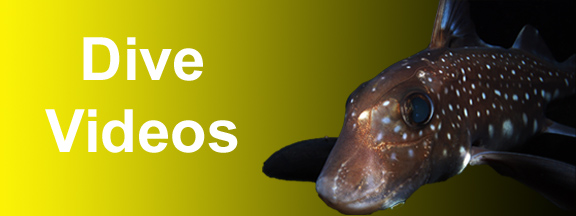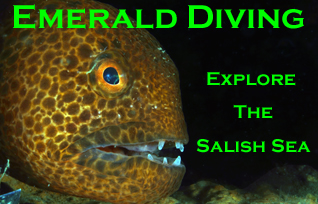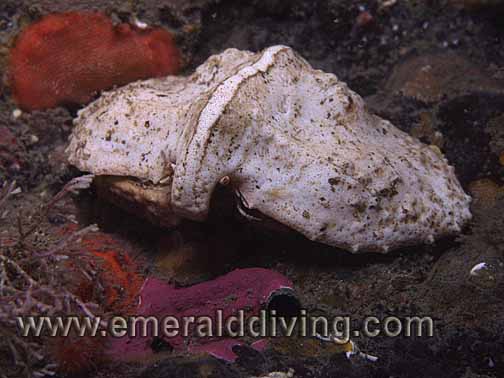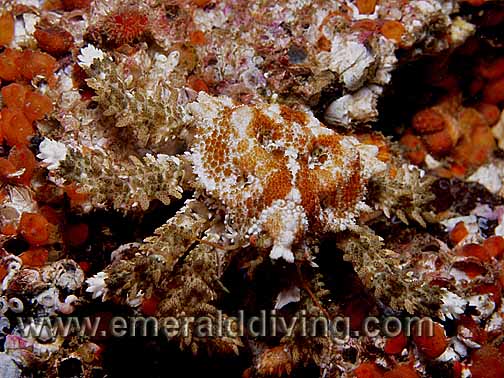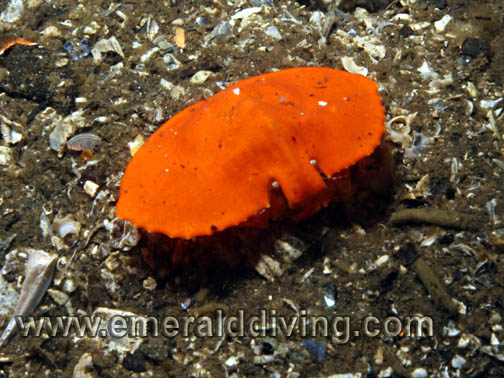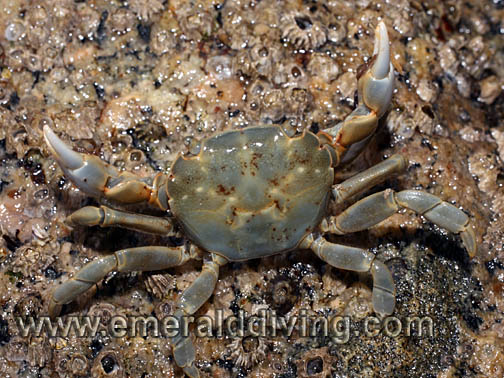

The enlargement viewer only works properly once ALL images on this page are loaded.
Bering Hermit
Pagurus beringanus
Typical size: 1 across carapace
ID: Thin orange bands on hairy legs. Small eyes
Comments: I often note the spindly Bering hermit when diving Puget Sound. It is probably the second most common hermit I note, the blackeye hermit being at the top of the list. Although both species have orange marking on their legs, the tiny eyes of the Bering hermit make it easily identifiable.
Pagurus beringanus
Typical size: 1 across carapace
ID: Thin orange bands on hairy legs. Small eyes
Comments: I often note the spindly Bering hermit when diving Puget Sound. It is probably the second most common hermit I note, the blackeye hermit being at the top of the list. Although both species have orange marking on their legs, the tiny eyes of the Bering hermit make it easily identifiable.
Blackeye Hermit
Pagurus armatus
Typical size: 1-2 across carapace
ID: Large oval black eyes. Usually makes use of abandoned moon snail shells. White and orange markings on legs.
Comments: I note the blackeye hermit more than any other hermit in Washington waters. This hermit can grow quite large. I oten find the blackeye hermit amongst eelgrass and kelp beds on soft substates. I have never noted a blackeye hermit in anything but an abandonned moon snail shell.
Pagurus armatus
Typical size: 1-2 across carapace
ID: Large oval black eyes. Usually makes use of abandoned moon snail shells. White and orange markings on legs.
Comments: I note the blackeye hermit more than any other hermit in Washington waters. This hermit can grow quite large. I oten find the blackeye hermit amongst eelgrass and kelp beds on soft substates. I have never noted a blackeye hermit in anything but an abandonned moon snail shell.
Butterfly Crab
Cryptolithodes typicus
Typical size: 1-3 across carapace
ID: Uniquely shaped shell. Coloration varies greatly. Rostrum (nose portion of the shell) does not flare at the end.
Comment: I often note the elusive butterfy crab when diving the San Juan Islands, and seldom anywhere else. This crab is often mistaken for an umbrella crab, which was a flaiedr rostrum. This picture was taken at Cone Island in the San Juans.
Cryptolithodes typicus
Typical size: 1-3 across carapace
ID: Uniquely shaped shell. Coloration varies greatly. Rostrum (nose portion of the shell) does not flare at the end.
Comment: I often note the elusive butterfy crab when diving the San Juan Islands, and seldom anywhere else. This crab is often mistaken for an umbrella crab, which was a flaiedr rostrum. This picture was taken at Cone Island in the San Juans.
Dungeness Crab
Cancer magister
Typical size: 4-8 across carapace
ID: Purplish-brown carapace, pinchers predominately white with several rows of rough protrusions along top edge.
Comments: The highly prized dungeness crab is a common inhabitant of sandy substrates throughout the Northwest. Dungensess crabs molt in summer. I have witness massive motling events involving thousands of male dungeness crabs in the Cape Flattery area. And yes, these crabs can pitch very hard.
Cancer magister
Typical size: 4-8 across carapace
ID: Purplish-brown carapace, pinchers predominately white with several rows of rough protrusions along top edge.
Comments: The highly prized dungeness crab is a common inhabitant of sandy substrates throughout the Northwest. Dungensess crabs molt in summer. I have witness massive motling events involving thousands of male dungeness crabs in the Cape Flattery area. And yes, these crabs can pitch very hard.
Graceful Crab
Cancer gracilis
Typical size: 3-4 across carapace
ID: Teeth along front of carapace lined in white. Smooth pinchers with white tips.
Comments: I only occasionally note the graceful crab as it prefers shallow and soft substrates. The shallows at Three Tree Point are a good place to encounter this species. The graceful crab is very similar in appearance to the Dungeness crab, however it is much smaller and lacks the teeth along the edge of the pinchers.
Cancer gracilis
Typical size: 3-4 across carapace
ID: Teeth along front of carapace lined in white. Smooth pinchers with white tips.
Comments: I only occasionally note the graceful crab as it prefers shallow and soft substrates. The shallows at Three Tree Point are a good place to encounter this species. The graceful crab is very similar in appearance to the Dungeness crab, however it is much smaller and lacks the teeth along the edge of the pinchers.
Northern Kelp Crab
Pugettia producta
Typical size: 1-3 across carapace
ID: Smooth carapace top. Brown, brown-yellow, or dark red carapace. Yellow or bright red underside.
Comments: I can't remember the last dive that I didn't note the seemingly ever-present northern kelp crab. These crabs tend to take on a color that best matches the regional kelp and can range in color from yellow-brown to deep red. I note these crabs on piling, reefs, wrecks, or anywhere kelp thrives.
Pugettia producta
Typical size: 1-3 across carapace
ID: Smooth carapace top. Brown, brown-yellow, or dark red carapace. Yellow or bright red underside.
Comments: I can't remember the last dive that I didn't note the seemingly ever-present northern kelp crab. These crabs tend to take on a color that best matches the regional kelp and can range in color from yellow-brown to deep red. I note these crabs on piling, reefs, wrecks, or anywhere kelp thrives.
Heart Crab
Phyllolithodes papillosus
Typical size: 1-2 across carapace
ID: Spiny legs. Triangular carapace. Top of the carapace sports a raised outline in the shape of a heart.
Comments: With its thick bristling legs and mottled carapace, I am sure I often overlook the well camouflaged heart crab unless it moves. My best luck for finding this species is in the San Juan Islands,but I have noted it inhabiting rocky reefs throughout Puget Sound and Hood Canal.
Phyllolithodes papillosus
Typical size: 1-2 across carapace
ID: Spiny legs. Triangular carapace. Top of the carapace sports a raised outline in the shape of a heart.
Comments: With its thick bristling legs and mottled carapace, I am sure I often overlook the well camouflaged heart crab unless it moves. My best luck for finding this species is in the San Juan Islands,but I have noted it inhabiting rocky reefs throughout Puget Sound and Hood Canal.
Orange Hairy Hermit
Paguristes turgidus
Typical size: 1 across carapace
ID: Orange colored body, very small eyes, and long dark hair-like strands emanating from legs and claws.
Comments: I have only noted this species once - at Three Tree Point in about 40 feet of water. This hermit tends to favor discarded shells from Oregon tritons.
Paguristes turgidus
Typical size: 1 across carapace
ID: Orange colored body, very small eyes, and long dark hair-like strands emanating from legs and claws.
Comments: I have only noted this species once - at Three Tree Point in about 40 feet of water. This hermit tends to favor discarded shells from Oregon tritons.
Pygmy Rock Crab
Cancer oregonesis
Typical size: 1-2 across carapace
ID: Rounded shell. Shell color varies and includes reds, browns, and whites. Black pincher tips.
Comments: The pygmy rock crab is actually a common inhabitant of our Northwest reefs, but usually goes unnoticed. In addition to being relatively small and well camouflaged, it seems to prefer to hide inside abandonned giant barnacle shells.
Cancer oregonesis
Typical size: 1-2 across carapace
ID: Rounded shell. Shell color varies and includes reds, browns, and whites. Black pincher tips.
Comments: The pygmy rock crab is actually a common inhabitant of our Northwest reefs, but usually goes unnoticed. In addition to being relatively small and well camouflaged, it seems to prefer to hide inside abandonned giant barnacle shells.
Puget Sound King Crab
Lopholithodes mandtii
Typical size: 2-12 across carapace
ID: Large, pronounced bumps on carapace top. Adults are predominately orange or orange/red with a mix of white, yellow and purple markings. Juveniles are often a red and/or orange.
Comments: The rugged looking Puget Sound king crab is the largest crab in Northwest waters. I commonly note this species in the San Juan Island, and less often in the Cape Flattery area. I have only seen one of these crabs in Puget Sound - a juvenile at Possession Point.
Lopholithodes mandtii
Typical size: 2-12 across carapace
ID: Large, pronounced bumps on carapace top. Adults are predominately orange or orange/red with a mix of white, yellow and purple markings. Juveniles are often a red and/or orange.
Comments: The rugged looking Puget Sound king crab is the largest crab in Northwest waters. I commonly note this species in the San Juan Island, and less often in the Cape Flattery area. I have only seen one of these crabs in Puget Sound - a juvenile at Possession Point.
Red Rock Crab Juvenile
Cancer productus
Typical size: 1 across carapace
ID: White carapace, sometimes with designs. Black pinchers. Carapace broad and not deep.
Comments: The bland color of the juvenile red rock crabs sometimes makes it difficult to find. This youngster already has characteristics of its adult form - specifically the carapace shape and black pincher ends. Photographed at China Wall on the west side of Blakely Rock in Puget Sound.
Cancer productus
Typical size: 1 across carapace
ID: White carapace, sometimes with designs. Black pinchers. Carapace broad and not deep.
Comments: The bland color of the juvenile red rock crabs sometimes makes it difficult to find. This youngster already has characteristics of its adult form - specifically the carapace shape and black pincher ends. Photographed at China Wall on the west side of Blakely Rock in Puget Sound.
Spiny Lithoid Crab
Acantholithodes hispidus
Typical size: 1-4 across carapace
ID: Spiny arms and carapace, banded red, brown, and white legs.
Comments: I have only noted this unusual crab at Pulali Wall in Hood Canal. The spiny lithoid crab could just as easily be named the porcupine crab.
Acantholithodes hispidus
Typical size: 1-4 across carapace
ID: Spiny arms and carapace, banded red, brown, and white legs.
Comments: I have only noted this unusual crab at Pulali Wall in Hood Canal. The spiny lithoid crab could just as easily be named the porcupine crab.
Sharpnose Crab
Scyra acutifrons
Typical size: 1-1.5 across carapace
ID: Unusual shovel-like nose, relatively short legs, large orange pinchers. Typically covered in sponges.
Comments: The sharpnose crab is easily distinguished by its unique wide rostrum (nose, if you will). This crab is often hard to detect as it is usually covered in small invertebrates. There is nothing like t ravelling with friends.
Scyra acutifrons
Typical size: 1-1.5 across carapace
ID: Unusual shovel-like nose, relatively short legs, large orange pinchers. Typically covered in sponges.
Comments: The sharpnose crab is easily distinguished by its unique wide rostrum (nose, if you will). This crab is often hard to detect as it is usually covered in small invertebrates. There is nothing like t ravelling with friends.
Widehand Hermit
Elassochirus tenuimanus
Typical size: 1 across carapace
ID: Blue coloration at base of legs, oversized flat right claw.
Comments: I often note the distinctive widehand hermit when diving reefs throughout the Northwest. This crab will use a number of differnt species of snail shell for its condo, including purple ringtop snail shells. Unlike the blackeye hermit, this crab has beady little yellow eye.
Elassochirus tenuimanus
Typical size: 1 across carapace
ID: Blue coloration at base of legs, oversized flat right claw.
Comments: I often note the distinctive widehand hermit when diving reefs throughout the Northwest. This crab will use a number of differnt species of snail shell for its condo, including purple ringtop snail shells. Unlike the blackeye hermit, this crab has beady little yellow eye.
Helmet Crab
Telmessus cheiragonus
Typical size: 2-3 across carapace
ID: Yellow colored body and legs. 12 teeth across carapase. Hairy legs.
Comments: My observations are the helmet crab is very skittish and prefesr to stay hidden amongst think groves of kelp. I only note this crab in late spring, summer, and fall months. It may retreat to deeper water during the winter.
Telmessus cheiragonus
Typical size: 2-3 across carapace
ID: Yellow colored body and legs. 12 teeth across carapase. Hairy legs.
Comments: My observations are the helmet crab is very skittish and prefesr to stay hidden amongst think groves of kelp. I only note this crab in late spring, summer, and fall months. It may retreat to deeper water during the winter.
Puget Sound King Crab - Juvenile
Lopholithodes mandtii
Typical size: 2-3 across carapace
ID: Very large peaks across carapace. Bright orange and red color with blue spots.
Comments: I see about as many juvenile Puget Sound kings crabs as I do adults. These crabs are often well camouflaged when they remain stationary amongst a background of colorful invertebrates.
Lopholithodes mandtii
Typical size: 2-3 across carapace
ID: Very large peaks across carapace. Bright orange and red color with blue spots.
Comments: I see about as many juvenile Puget Sound kings crabs as I do adults. These crabs are often well camouflaged when they remain stationary amongst a background of colorful invertebrates.
Maroon Hermit
Pagurus hemphilli
Typical size: 0.5-1" across carapace
ID: Distinctive orange body with small yellow eyes.
Comments: This brightly colored crab is fairly common in the San Juan Islands. It's solid orange body makes it hard to confuse with any other species. This photo was taken on Long Island West Wall. Although this little guy is in a blue ringtop snail shell, maroon hermits often occupy purple ringtop snail shells.
Pagurus hemphilli
Typical size: 0.5-1" across carapace
ID: Distinctive orange body with small yellow eyes.
Comments: This brightly colored crab is fairly common in the San Juan Islands. It's solid orange body makes it hard to confuse with any other species. This photo was taken on Long Island West Wall. Although this little guy is in a blue ringtop snail shell, maroon hermits often occupy purple ringtop snail shells.
Graceful Decorator Crab
Oregonia gracilis
Typical size: 1 across carapace
ID: Long and slender walking legs. Triangular carapace with two long and parallel horns that are close together.
Comments: Can you find the crab in this photo? The most accomplished of the decorators, this crab is often covered with local representative invertebrate species to the point that it is indistinguishable. I often find this prolific dresser throughout Washington waters. Photo take at Tatoosh Island in the Cape Flattery area.
Oregonia gracilis
Typical size: 1 across carapace
ID: Long and slender walking legs. Triangular carapace with two long and parallel horns that are close together.
Comments: Can you find the crab in this photo? The most accomplished of the decorators, this crab is often covered with local representative invertebrate species to the point that it is indistinguishable. I often find this prolific dresser throughout Washington waters. Photo take at Tatoosh Island in the Cape Flattery area.
Moss Crab
Loxorhynchus crispatus
Typical size: 2" across carapace
ID: Triangular carapace heavily encrusted with sponge. Thick walked legs.
Comments: I believe this crab is a moss crab, which can reported grow to a 5" across the carapace. I have only rarely noted this species when diving the Cape Flattery area.
Loxorhynchus crispatus
Typical size: 2" across carapace
ID: Triangular carapace heavily encrusted with sponge. Thick walked legs.
Comments: I believe this crab is a moss crab, which can reported grow to a 5" across the carapace. I have only rarely noted this species when diving the Cape Flattery area.
Graceful Kelp Crab
Pugettia gracilis
Typical size: 1-1.5 across carapace
ID: Blue pinchers with orange tips. Bumps on carapace, but no spines. Broad "hook" on first carapace tooth on either side. Medium length horns that have significant space between them and slightly diverge.
Comments: This crab does decorate, but unlike the graceful decorator crab, it tends to keep the decoration simple and only decorate its rostrum. Also not the blue pincher tipped with orange. Photo taken at KVI Tower Reef in Puget Sound.
Pugettia gracilis
Typical size: 1-1.5 across carapace
ID: Blue pinchers with orange tips. Bumps on carapace, but no spines. Broad "hook" on first carapace tooth on either side. Medium length horns that have significant space between them and slightly diverge.
Comments: This crab does decorate, but unlike the graceful decorator crab, it tends to keep the decoration simple and only decorate its rostrum. Also not the blue pincher tipped with orange. Photo taken at KVI Tower Reef in Puget Sound.
Longhorn Decorator Crab
Chorilia longipes
Typical size: 1-2 across carapace
ID: Orange colored body, with two long and parallel horns. Carapace has small spines. Long walking legs.
Comments: This little crab is a relatively modest decorator. I often note this crab while diving Hood Canal. Photo taken at Flagpole Point.
Chorilia longipes
Typical size: 1-2 across carapace
ID: Orange colored body, with two long and parallel horns. Carapace has small spines. Long walking legs.
Comments: This little crab is a relatively modest decorator. I often note this crab while diving Hood Canal. Photo taken at Flagpole Point.
Golf-ball Crab
Rhinolithodes wosnessenskii
Typical size: 1-2 across carapace
ID: Triangular carapace with golf-ball like protrusion. Legs covered in brown hair.
Comments: I only occasionally find this unusual lithoid crab - probably because it is very well camouflaged unless it moves. This photo was taken on a deep wall in 105 feet of water at Pile Point. This crab is also referred to as a rhinosaurus crab.
Rhinolithodes wosnessenskii
Typical size: 1-2 across carapace
ID: Triangular carapace with golf-ball like protrusion. Legs covered in brown hair.
Comments: I only occasionally find this unusual lithoid crab - probably because it is very well camouflaged unless it moves. This photo was taken on a deep wall in 105 feet of water at Pile Point. This crab is also referred to as a rhinosaurus crab.
Puget Sound King Crab -
Young Juvenile
Lopholithodes mandtii
Typical size: 1 across carapace
ID: Very large peaks across carapace. Solid bright orange color.
Comments: I often spot these young crabs with my HID light as the bright orange really sticks out against most backgrounds. Withough white light, the orange color turns grey and the crab blends in with the background. Photo taken at Edmonds Underwater Park - believe it or not!
Young Juvenile
Lopholithodes mandtii
Typical size: 1 across carapace
ID: Very large peaks across carapace. Solid bright orange color.
Comments: I often spot these young crabs with my HID light as the bright orange really sticks out against most backgrounds. Withough white light, the orange color turns grey and the crab blends in with the background. Photo taken at Edmonds Underwater Park - believe it or not!
Scaled Crab
Placetron wosnessenskii
Typical size: 2 across carapace
ID: Distinctive trapezoid shaped carapace and long, slender pinchers. Top of carapace, legs, and pinchers covered in scales.
Comments: I only regularly note adult versions of this unique crab when diving Pulali Point in Hood Canal, which is where this photo was taken.
Placetron wosnessenskii
Typical size: 2 across carapace
ID: Distinctive trapezoid shaped carapace and long, slender pinchers. Top of carapace, legs, and pinchers covered in scales.
Comments: I only regularly note adult versions of this unique crab when diving Pulali Point in Hood Canal, which is where this photo was taken.
Umbrella Crab
Crypolithodes sitchensis
Typical size: 1-3 across carapace
ID: Unique carpace wtih flared rostrum. Coloration varies.
Comments: This little crab only live in coastal waters. Thanks to Andy Lamb for finding this little umbrella crab in Barkley Sound underneath a colony of orange social ascidians, which explains the bright orange color.
Crypolithodes sitchensis
Typical size: 1-3 across carapace
ID: Unique carpace wtih flared rostrum. Coloration varies.
Comments: This little crab only live in coastal waters. Thanks to Andy Lamb for finding this little umbrella crab in Barkley Sound underneath a colony of orange social ascidians, which explains the bright orange color.
Red Rock Crab
Cancer productus
Typical size: 4-6 across carapace
ID: Red to purple carapace, legs and pinchers. Pinchers are tipped in black.
Comments: I commonly note the red rock crab on reefs and soft substrates throughout Washington waters. Like the Dungeness crab, the red rock crab often buries itself in the sand for camoufalge. If you are ever have a finger pinched on land by a red rock crab, lift your hand up as the red rock crab's arm can't support its weight when out of the water. Be warned - this crab can pinch very hard.
Cancer productus
Typical size: 4-6 across carapace
ID: Red to purple carapace, legs and pinchers. Pinchers are tipped in black.
Comments: I commonly note the red rock crab on reefs and soft substrates throughout Washington waters. Like the Dungeness crab, the red rock crab often buries itself in the sand for camoufalge. If you are ever have a finger pinched on land by a red rock crab, lift your hand up as the red rock crab's arm can't support its weight when out of the water. Be warned - this crab can pinch very hard.
Flattop Crab
Petrolistthes eriomerus
Typical size: 0.5" across carapace
ID: Large, flat pinchers. Blue thumb-joints.
Comments: You have to turn over some rocks if you want to find this little crab. The blue joint where the thumb meets the rest of the pincher makes this an easy ID as a flattop crab. Getting this little crab to hold still for a picture is almost impossible as they are hell-bent on finding a rock to hide under. Photographed in the shallows at Browning Wall in unbelievable Browning Pass, BC.
Petrolistthes eriomerus
Typical size: 0.5" across carapace
ID: Large, flat pinchers. Blue thumb-joints.
Comments: You have to turn over some rocks if you want to find this little crab. The blue joint where the thumb meets the rest of the pincher makes this an easy ID as a flattop crab. Getting this little crab to hold still for a picture is almost impossible as they are hell-bent on finding a rock to hide under. Photographed in the shallows at Browning Wall in unbelievable Browning Pass, BC.
Green Shore Crab
Hemigrapsus oregonensis
Typical size: 1 across carapace
ID: Typically green body with white tipped pinchers. Tiny hairs on legs.
Comments: A common crab found by beachcombers who turn over rocks. When exposed, this little crab often scampers and hides under the closest rock. The crab in this picture has given up on fleeing and assumed a defensive position. Photographed on Hurst Island, British Columbia.
Hemigrapsus oregonensis
Typical size: 1 across carapace
ID: Typically green body with white tipped pinchers. Tiny hairs on legs.
Comments: A common crab found by beachcombers who turn over rocks. When exposed, this little crab often scampers and hides under the closest rock. The crab in this picture has given up on fleeing and assumed a defensive position. Photographed on Hurst Island, British Columbia.
Purple Shore Crab
Hemigrapsus nudus
Typical size: 0.5-1" across carapace
ID: Coloration can vary, but typically purple body and legs with yellow blotches. No hair on legs.
Comments: It is often difficult to avid this species when turning over rocks on a rocky shoreline. This species is seldom seen by divers, but is a common encounter for beachcombers. Photographed at God's Pocket on Hust Island, British Columbia.
Hemigrapsus nudus
Typical size: 0.5-1" across carapace
ID: Coloration can vary, but typically purple body and legs with yellow blotches. No hair on legs.
Comments: It is often difficult to avid this species when turning over rocks on a rocky shoreline. This species is seldom seen by divers, but is a common encounter for beachcombers. Photographed at God's Pocket on Hust Island, British Columbia.
Greenmark Hermit
Pagurus caurinus
Typical size: 0.5" across carapace
ID: White banded legs and unbanded orange antenna.
Comments: You need to loock very carefully to distinguish this little hermit. Andy Lamb found this hermit while we were diving Norway Island in the Canadian Guld Islands.
Pagurus caurinus
Typical size: 0.5" across carapace
ID: White banded legs and unbanded orange antenna.
Comments: You need to loock very carefully to distinguish this little hermit. Andy Lamb found this hermit while we were diving Norway Island in the Canadian Guld Islands.
Black Claw Crab
Lophopanopeus bellus
Typical size: 0.75 across carapace
ID: Three grooves outside either eye. Differentiated from the purple shore crab by the small hairs on legs and carapace. High variation of dark colors.
Comments: These little crabs often make themselves scarce as they like to hide under rocks or other cover. This specimen was uncovered in 25 feet of water at the KVI Tower dive site off Vashon Island in Puget Sound. Hey - how can this be a black claw crab as it has purple claws?
Lophopanopeus bellus
Typical size: 0.75 across carapace
ID: Three grooves outside either eye. Differentiated from the purple shore crab by the small hairs on legs and carapace. High variation of dark colors.
Comments: These little crabs often make themselves scarce as they like to hide under rocks or other cover. This specimen was uncovered in 25 feet of water at the KVI Tower dive site off Vashon Island in Puget Sound. Hey - how can this be a black claw crab as it has purple claws?







